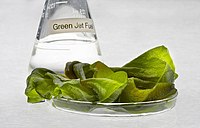
Photo from wikipedia
Natural algal bloom consists of promising algal species which could be a feasible option for the source of bulk biomass and biodiesel production. It has been found in five natural… Click to show full abstract
Natural algal bloom consists of promising algal species which could be a feasible option for the source of bulk biomass and biodiesel production. It has been found in five natural fresh water algal blooms (Uttar Pradesh, India), containing high nitrogen (N) (4.6 ± 0.32 mg/L) and phosphorus (P) (4.12 ± 0.29 mg/L) concentration during spring (23.9–25.9 °C) and summer season (32.0–35.0 °C). Among the isolated algae from naturally occurring bloom, Chlorella sorokiniana MKP01 exhibited highest biomass (1.02 ± 0.02 g/L) and lipid content (174.1 ± 9.6 mg/L) in untreated tap water and urea/single super phosphate (SSP) in the ratio (2:1). The biodiesel quality was assessed and found to be with the Indian and international standards. Algal bloom was artificially developed in the open pond containing 10,000 l tap water supplemented with Urea/SSP (2:1) for a consistent supply of bulk biomass, yielded 8 kg of total biomass and lipid 1.3 kg.
Journal Title: Applied Microbiology and Biotechnology
Year Published: 2019
Link to full text (if available)
Share on Social Media: Sign Up to like & get
recommendations!